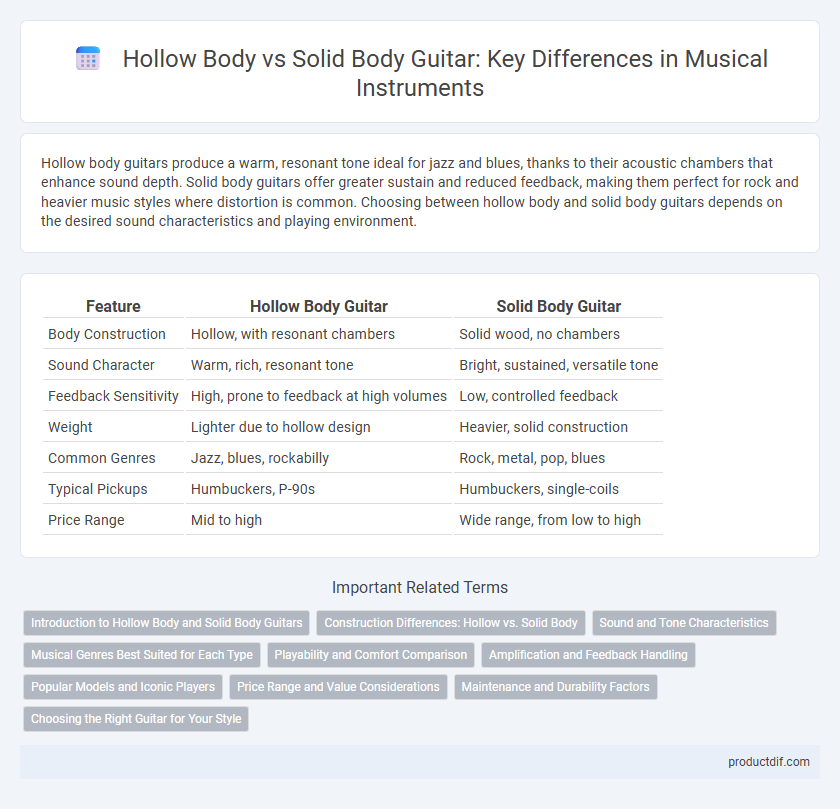Hollow body guitars produce a warm, resonant tone ideal for jazz and blues, thanks to their acoustic chambers that enhance sound depth. Solid body guitars offer greater sustain and reduced feedback, making them perfect for rock and heavier music styles where distortion is common. Choosing between hollow body and solid body guitars depends on the desired sound characteristics and playing environment.
Table of Comparison
| Feature | Hollow Body Guitar | Solid Body Guitar |
|---|---|---|
| Body Construction | Hollow, with resonant chambers | Solid wood, no chambers |
| Sound Character | Warm, rich, resonant tone | Bright, sustained, versatile tone |
| Feedback Sensitivity | High, prone to feedback at high volumes | Low, controlled feedback |
| Weight | Lighter due to hollow design | Heavier, solid construction |
| Common Genres | Jazz, blues, rockabilly | Rock, metal, pop, blues |
| Typical Pickups | Humbuckers, P-90s | Humbuckers, single-coils |
| Price Range | Mid to high | Wide range, from low to high |
Introduction to Hollow Body and Solid Body Guitars
Hollow body guitars feature a resonant, chambered construction that enhances acoustic sound projection, making them ideal for jazz and blues genres. Solid body guitars lack internal chambers, offering reduced feedback and greater sustain, favored in rock and metal styles. The structural differences directly influence tonal characteristics and playability, guiding musicians' instrument choice based on genre and sound preference.
Construction Differences: Hollow vs. Solid Body
Hollow body guitars feature a resonant chamber that enhances acoustic tone and warmth, often constructed with laminated wood to reduce feedback. Solid body guitars consist of a single solid piece of wood or multiple glued pieces, providing greater sustain and resistance to feedback, making them ideal for high-gain amplification. The construction differences influence sound projection, weight, and suitability for various music genres, with hollow bodies favored in jazz and blues and solid bodies dominating rock and metal.
Sound and Tone Characteristics
Hollow body guitars produce warm, resonant tones with natural acoustic qualities and rich, complex harmonics, ideal for jazz and blues. Solid body guitars offer a brighter, more focused sound with greater sustain, reduced feedback, and enhanced versatility, favored in rock and metal genres. The construction and material differences significantly influence the tonal response and feedback sensitivity in performance settings.
Musical Genres Best Suited for Each Type
Hollow body guitars excel in jazz, blues, and rockabilly due to their warm, resonant tones that complement smooth, melodic playing styles. Solid body guitars are preferred in rock, metal, and pop genres for their sustain, tonal consistency, and ability to handle high gain without feedback. The choice between hollow and solid body guitars significantly impacts the sonic character and genre suitability of the instrument.
Playability and Comfort Comparison
Hollow body guitars offer a lightweight design and a resonant, warm tone that enhances comfort during extended play, ideal for jazz and blues musicians. Solid body guitars provide superior sustain and feedback resistance, favoring players who prioritize precision and durability in various genres such as rock and metal. The choice between hollow and solid body guitars significantly impacts playability, with hollow bodies allowing greater ease of movement and solid bodies offering more stability under aggressive playing styles.
Amplification and Feedback Handling
Hollow body guitars excel in producing warm, resonant tones ideal for jazz and blues, but their thin, hollow construction makes them more susceptible to feedback when amplified at high volumes. Solid body guitars feature a dense, solid wood design that significantly reduces feedback issues, enabling higher gain and distortion levels suitable for rock and metal genres. Amplifiers paired with hollow body guitars often require careful EQ adjustments and feedback suppression techniques, while solid bodies provide cleaner signal amplification with greater feedback control.
Popular Models and Iconic Players
The hollow body guitar is epitomized by models like the Gibson ES-335, favored by jazz legends such as Wes Montgomery and B.B. King for its warm, resonant tone. In contrast, solid body guitars like the Fender Stratocaster and Gibson Les Paul dominate rock and blues genres, with iconic players including Jimi Hendrix and Eric Clapton shaping their signature sounds. These instruments' construction directly influences their sound profile, with hollow bodies offering rich, acoustic qualities and solid bodies providing sustain and distortion capabilities ideal for diverse musical styles.
Price Range and Value Considerations
Hollow body guitars generally range from $500 to $3000, offering warm, resonant tones ideal for jazz and blues, but they can be prone to feedback at high volumes. Solid body guitars typically span $200 to $4000+, providing greater versatility and sustain, favored in rock and metal genres due to their resistance to feedback and durability. Value considerations depend on intended genre and playing style, with hollow bodies delivering vintage aesthetics and rich sound, while solid bodies offer reliable performance and broader tonal options.
Maintenance and Durability Factors
Hollow body guitars require more careful maintenance due to their sensitive wooden chambers, which are prone to damage from humidity and temperature fluctuations, affecting their structural integrity and tone quality. Solid body guitars offer superior durability with a robust construction that withstands physical impacts and environmental stress, making them ideal for rigorous performance conditions. Proper care for hollow bodies includes regular humidity control and delicate cleaning, while solid bodies need minimal maintenance beyond routine string changes and fretboard conditioning.
Choosing the Right Guitar for Your Style
Hollow body guitars offer rich, warm tones ideal for jazz, blues, and rockabilly styles due to their resonant chambers that enhance acoustic sound. Solid body guitars provide greater sustain and reduced feedback, making them perfect for rock, metal, and high-gain applications where clarity and durability matter. Selecting the right guitar depends on your preferred genre, playing environment, and tonal preferences to ensure optimal performance and sound.
Hollow body guitar vs Solid body guitar Infographic

 productdif.com
productdif.com